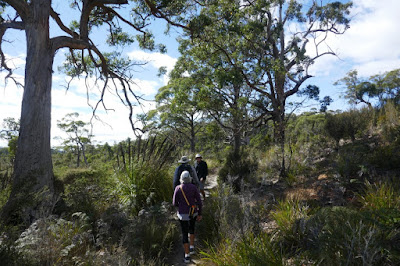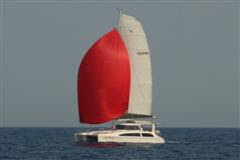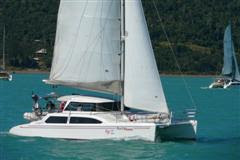Monday, 18 March to Friday, 22 March 2019
After our Channel cruising, we had a night at Constitution
Dock and then a night at the Prince of Wales Bay Marina for washing and
restocking for the trip home. Our original plan to take our time going up the
east coast of Tasmania was amended when we looked at the weather for the next
week. There was a good window to cross Bass Strait if we left as soon as
possible, if we delayed at all, then there was no opportunity for the coming 10
days.
 |
| Farewell to Hobart on a beautiful afternoon |
We therefore left Hobart after lunch and refuelling at the Royal Yacht Club of Tasmania, sailed down the
Derwent past the Iron Pot and anchored at Lagoon Beach in Frederick Henry Bay.
We left the anchorage at 0745 on Wednesday and motored to
Denison Canal. Luckily the tides were in our favour and we went through the
canal about 0930.
 |
| Looks narrow as we approach |
 |
| Canal was dug by convicts so is not wide |
 |
| Champagne sailing in the slight seas |
We had good 15-20 knot ESE winds all Thursday night and we
were going well but with the frustration of a 2 knot current against us. We had
the Iridium Go satellite phone to get weather updates and send and receive text
messages and emails. Our friend Eva (SV Zofia) was keeping me company with current updates
and news of friends still in Tassie. Her hope that we might get favourable
currents soon did not eventuate until we neared the mainland on Friday afternoon.
We were abeam Gabo light at 1740 and Green Cape at 2030. By 2200
however, with the wind directly behind us, we decided to start an engine and
motor the last few miles to Twofold Bay. We dropped anchor in Snug Cove, Eden
at 2355 on Friday night with a light NE breeze just starting to blow.
We had 447nm on the log and had covered 384nm over
the ground in the 64 hours since we left Lagoon Beach. Our time from Schouten Passage
to Twofold Bay was 54 hours (38.5hrs sailing and 15.5hrs motoring) compared to
47 hours coming down.
We awoke Saturday morning to a moderate to strong northerly
and we were glad we had taken the decision to leave Tasmania when we did. It
meant, however, that we sailed past Wineglass Bay for the fifth time. Ah well, maybe
next time.














































